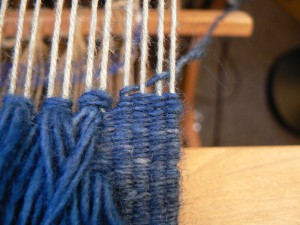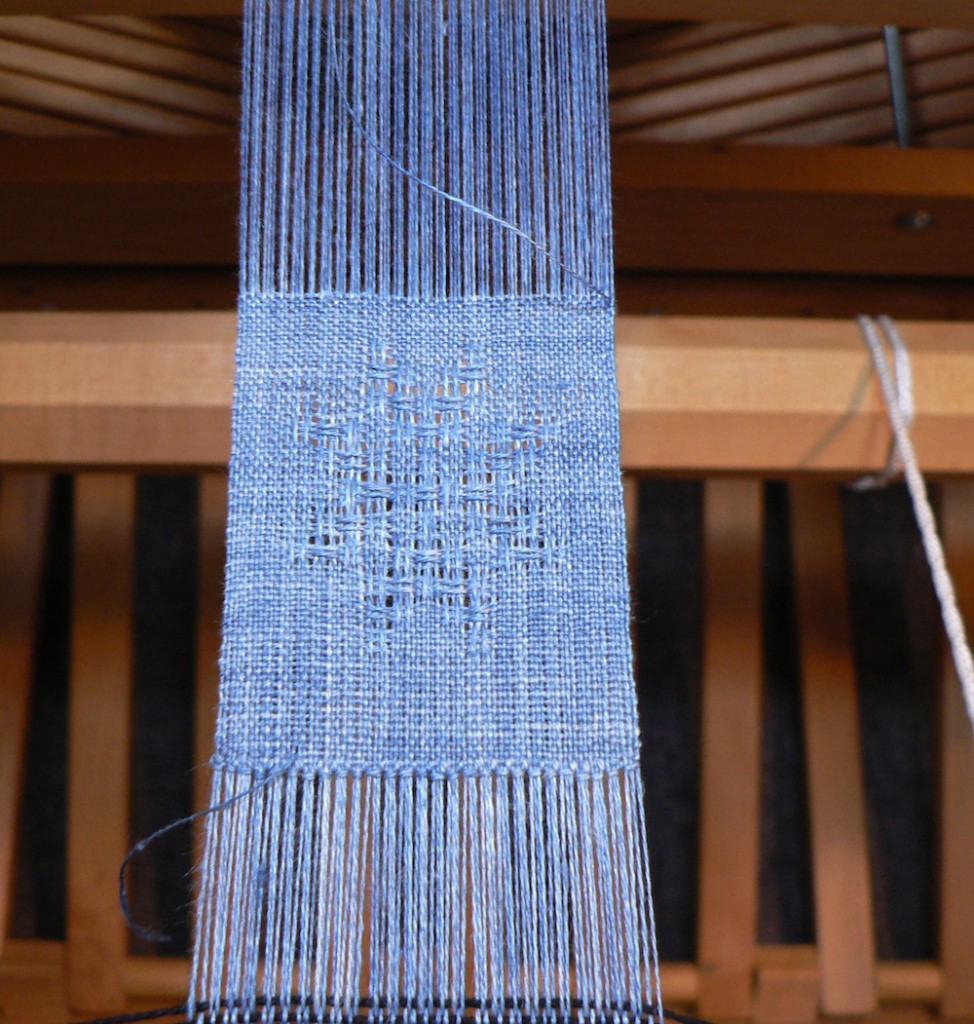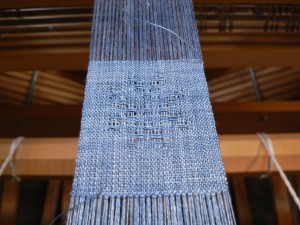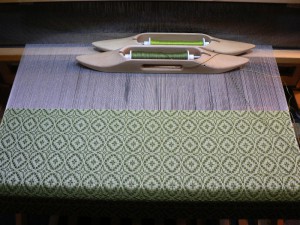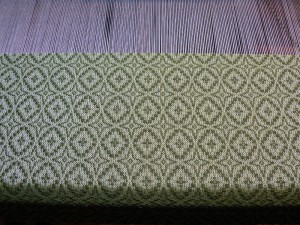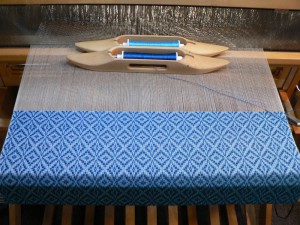Thanks to a snow day on Friday February 8th, courtesy of winter storm Nemo, I got a lot of weaving done on my rya. I was well past the mid-way point by mid-day on Saturday. However, I decided I wasn’t satisfied with the transition from green to celedon to yellow at the center. In the process of redesigning this transition, I decided to make the whole design taller, i.e., more square. I wasn’t looking forward to all the extra work of re-weaving, but I decided I’d rather have a piece I was happy with. Continue reading “Re-Weaving the Rya”
Rya Knots
Rya is a Swedish technique for making long-pile rugs or wall-hangings. Historically, as I understand it, these textiles were used as bed-covers. The pile side faced your body in bed, and the “back” side faced up. I am weaving this one to be a wall-hanging.
The knots don’t go all the way to the selvedge. Instead, there is a small area of plain weave at each selvedge called the argatch. Here’s how I weave it:
Rya Weaving
After about two years of planning a series of naturally dyed rya wall-hangings in my mind, I am finally weaving one! I am very excited about it. There are many steps involved. First, I dyed pounds and pounds of woolen yarn. You can read about the process in earlier posts: black walnut, Lady’s bedstraw, Queen Anne’s Lace and woad, and orange cosmos. This project features Queen Anne’s Lace and woad.
Then, I set up the warp. It is 8/4 natural linen from Webs,124 ends, a little shy of 21 inches wide in the reed, set at 6 ends per inch in a 12 dent reed, sleyed 1-0-1-0-1- etc.. When it’s done I expect it will be about 14 inches high. Continue reading “Rya Weaving”
Perchta and Flax Burning
I have been having a hard time wrapping up this thread because the more I read, the more complicated this whole subject becomes. I was initially annoyed by the idea of wanton flax-destruction on St. Distaff’s Day or Rock Day (a rock is a distaff). Then I was intrigued by the relationship between St. Distaff’s Day/Rock Day and Plough Monday, which is the following day. Known by these names, these two traditions appear to be mostly English. However, there are plenty of similarities to other holidays in other parts of Europe that are celebrated around the same time. Then I became intrigued by the holidays that are celebrated the night before St. Distaff’s Day. To sum up, there were theatrical antics on Twelfth Night/Perchtenlaufen, then antics on Rock Day, then more theatrical antics on Plough Day. The dates of these holidays are January 5th, 6th, and 7th, respectively. If everyone had to celebrate each of these holidays, we’d all have to spend several sleepless nights and exhausting days parading around in the snow in fantastic costumes, running or getting chased, making a lot of noise, getting wet and/or being set of fire. Phew. I can hardly get out of bed this time of year. The timing struck me as more than co-incidental. These holidays seem to be related, but how? Continue reading “Perchta and Flax Burning”
When to Weave and When Not
 I know that I ended my last two posts by saying that my “next” post would be about goddesses, carts, and plowing and/or Plough Day. Instead I continued to write about spinning prohibitions and the goddesses/folklore figures who imposed them. Well, this post isn’t about Plough Day, either. Sorry about that. I will get to it eventually. Very soon. I promise.
I know that I ended my last two posts by saying that my “next” post would be about goddesses, carts, and plowing and/or Plough Day. Instead I continued to write about spinning prohibitions and the goddesses/folklore figures who imposed them. Well, this post isn’t about Plough Day, either. Sorry about that. I will get to it eventually. Very soon. I promise.
Meanwhile, I have been doing more reading and thinking on the topic of why and when people may have engaged in or avoided certain tasks (spinning, weaving, plowing), and the festivals or traditions that demarcate the appropriate times for these labors. I’m still just talking about Europe, here.
Just as there were prohibitions against performing certain textile-related tasks on certain days, there were also days on which it was considered advantageous to begin or perform certain tasks. In the Carmina Gadelica I came across a footnote that mentions that “setting” the warp was done on a Thursday in Scotland. Continue reading “When to Weave and When Not”
Jack Frost Bookmarks
Well, as it turned out I wasn’t all that satisfied with the huck lace snowflake bookmarks. The variegation in the color made it difficult to see the pattern distinctly, and the shade of blue didn’t help either. This was ironic because I had been extremely happy with the yarn when I dyed it. It’s a nice dark blue, which is not easy to get with woad on cellulose. But it’s a bit too dark for effective lace, it seems. Not enough reflectivity, perhaps.
Here are a couple images of a snowflake motif in woad blue 40/2 linen.
Woad Dyed Snowflake Bookmarks in Huck Lace
It is tricky to squeeze in weaving around teaching and my shifts at the Shelburne Arts Co-op, since weaving is a time consuming process, multi-step. I usually have to break a project into incremental tasks. That way I can do a step even if I only have a small window of time, and still feel like I am making progress.
After I wove off the Hop Vine bookcloth, I planned to weave a new batch of bookmarks. For this wintery season, I planned to weave a huck lace snowflake motif, based on a project I developed for my Master Weaver Certificate. I called the original design “No Two Snowflakes Are Exactly Alike,” because the project featured 7 different snowflake motifs. To make it work with the same threading and treadling for each, I changed the tie-up between each snowflake. This was a time-consuming way to do it, and I decided it was impractical for items that I intended to sell. So, I decided to just pick one snowflake motif for this batch. I planned to use 40/2 linen naturally dyed with woad from my garden.
For this snowflake bookmark project, a lot of the steps were already done. The yarn was dyed (though still in skeins). The designing was already done. Often times I have to do some math to figure out if I have enough yarn of a given color to make a given project. For this project, I already knew how much dyed yarn I had and roughly how much I needed, based on my calculations from the heart-motif bookmarks. Continue reading “Woad Dyed Snowflake Bookmarks in Huck Lace”
Hop Vine Color and Design
This afternoon I wove off the rest of the Hop Vine warp. I am pretty pleased with the cloth, and have even come around to liking the three sections that I was so critical of in my last post.
To add some variation to the pattern, I decided to switch to the “rose fashion” treadling for the remainder of the warp. You can see the difference in the two photos below. The first one shows the star fashion treadling. It is a series of diamonds with strong diagonals. The second is the same pattern and tabby colors woven rose fashion. Four-pointed stars alternate with ovals to create more undulation.
Here’s a close up of the cloth with the rose fashion treadling.
I do think it is more dynamic with the alternating motifs. That shift alone added a bit more energy to the cloth. Continue reading “Hop Vine Color and Design”
More Hop Vine and A Color Theory Question
Matthew pointed out that I have been spelling Hop Vine two ways: Hopvine as one word, and Hop Vine as two words. This is because I have seen it written both ways, and personally I don’t have a strong preference. Perhaps I should be more consistent, but I don’t have good criteria for choosing between the two spellings. Without good criteria, some decisions just can’t be made. INTP anyone?
Meanwhile, here are three more pieces that I’ve woven on this warp. I re-wrote the treadling to maintain a consistent tabby order, so the pattern looks a little different from my earlier woad- and madder-dyed pieces. All the yarns in this group are commercially dyed.
The one below has 10/2 tencel in Moroccan Blue for the pattern weft and 20/2 UKI cotton in Deep Turk for tabby:
You can see the actual color of the 20/2 yarn on the bobbin closest to the reed. You might be asking, “What happened to that bright blue?” The background of the cloth looks very light because the warp is off-white. It mutes the tabby color. As I recall from a class on color theory for weavers with Susan Loring Wells, a color plus white is called a tint. Continue reading “More Hop Vine and A Color Theory Question”
Hopvine
My new book cloth is a variation of a miniature overshot motif called Hopvine. To create my threading I worked from two other drafts. One was “Modified Hopvine” from a sampler from the Hill Institute. The other was “Modified Hop Vine” from Marguerite Davison’s classic A Handweaver’s Pattern Book. The threading from Hill had too many ends in each pattern repeat to suit the scale of my book covers (5.5 inches by 8 inches) so I wanted to make the motif smaller. The Davison draft had fewer ends in a repeat but looked weirdly jittery in the drawdown in my weaving software.
So, I tinkered until I found a satisfying balance in the pattern, and am still tinkering with the treadling. The design consists of two different diamonds, one a longer and more pointed and the other a little more squat and rounded. I am not sure if these are supposed to evoke different elements of a hop vine, for example the leaves and the inflorescences. Or maybe the name of the pattern has a different origin. There are some nice images of hops plants here.
For those of you who recall my emboldening tabby travails of a year ago, you might be surprised to hear that I ran into the same problem of keeping a consistent tabby this time, also. Sigh. Continue reading “Hopvine”

